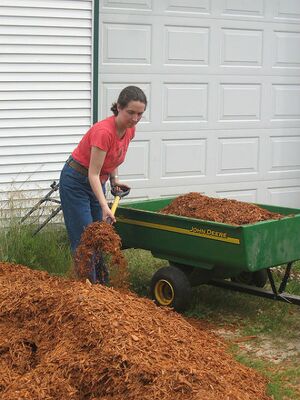Mulch
Mulch is a cover placed over soil to help retain moisture and to reduce opportunists.[1] Any material or combination can be used as mulch, such as stones, leaves, cardboard, wood chips, and gravel. Organic material are the most common as they can also absorb rainfall, reduce evaporation, provide nutrients, increase organic matter in the soil, feed and create habitat for soil organisms, suppress opportunistic plant growth and seed germination, moderate diurnal temperature swings, protect against frost, and reducing erosion. Mulch only covers the soil, and is not worked into the soil like amendments are.
Sheet mulching
Sheet mulching is an agricultural no-dig gardening technique that attempts to mimic natural processes occurring within forests. Sheet mulching mimics the leaf cover that is found on forest floors. When deployed properly and in combination with other Permacultural principles, it can generate healthy, productive and low maintenance ecosystems.
Sheet mulch serves as a "nutrient bank," storing the nutrients contained in organic matter and slowly making these nutrients available to plants as the organic matter slowly and naturally breaks down. It also improves the soil by attracting and feeding earthworms, slaters and many other soil micro-organisms, as well as adding humus. Earthworms "till" the soil, and their worm castings are among the best fertilizers and soil conditioners. Sheet mulching can be used to reduce or eliminate undesirable plants by starving them of light, and can be more advantageous than using herbicide or other methods of control.
Living Mulch
Hostas, planted densely, form thick coverings that smother grass and other plants. The leaves die back every year and help add organic matter to the soil. Stefan Sobkowiak, in the film The Permaculture Orchard, offered hostas as an alternative to plastic mulch in orchards.
